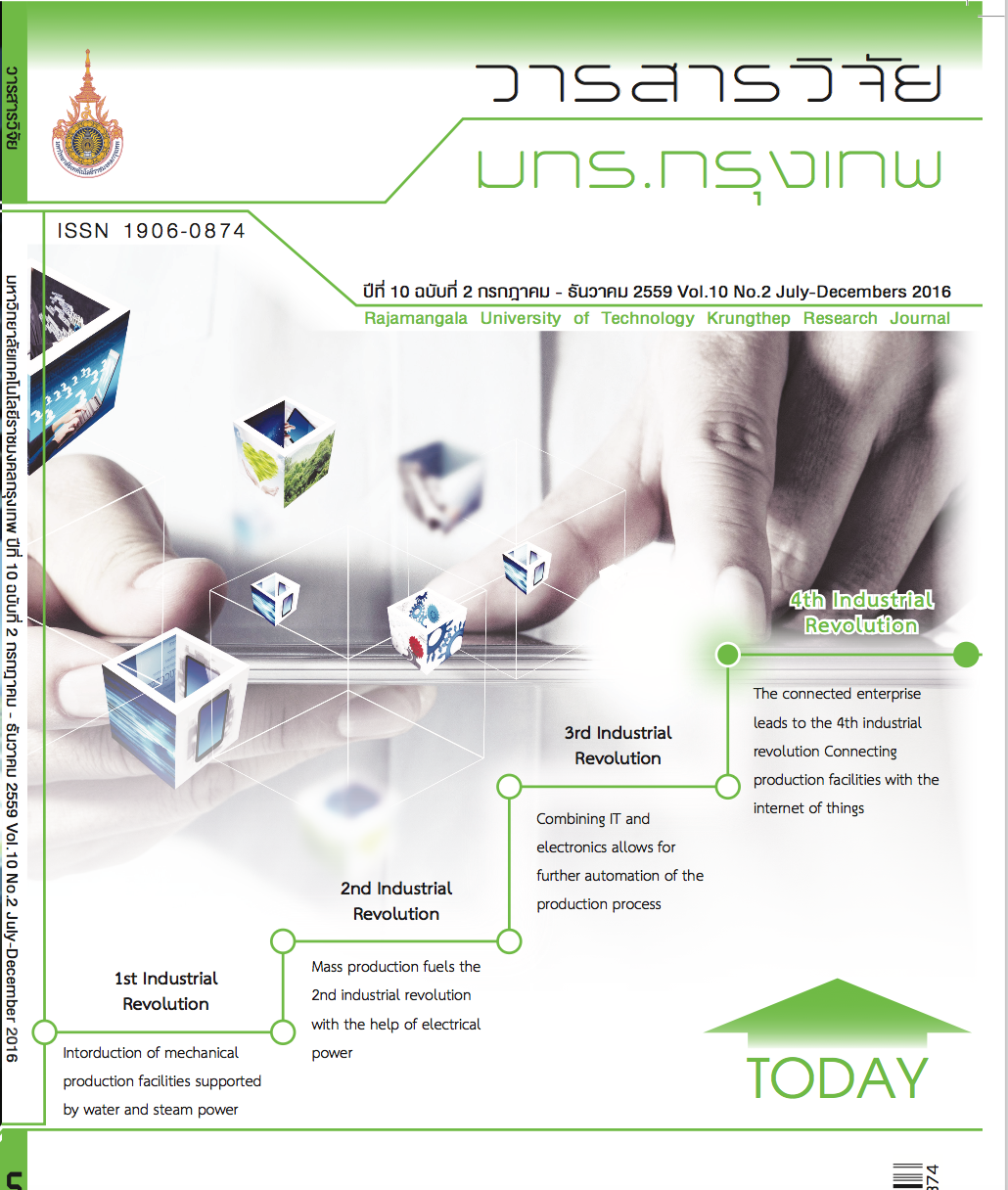ปัจจัยที่มีผลต่อประสิทธิภาพการย้อมผ้าฝ้ายด้วยน้ำหมาก
คำสำคัญ:
หมาก, ปูนแดง, พลู, สารผนึกสีบทคัดย่อ
งานวิจัยนี้ศึกษาปัจจัยที่มีผลต่อประสิทธิภาพการย้อมผ้าฝ้ายด้วยน้ำหมาก โดยเตรียมสารสกัดสีจากน้ำหมาก สัดส่วนน้ำหมาก : น้ำ เท่ากับ 1 : 5 อัตราส่วนระหว่าง หมาก : ปูนแดง : พลู คือ 4 : 3 : 1, 8 : 6 : 1 และ 10 : 8 : 1 เลือกอัตราส่วนผสมที่เหมาะสมร่วมกับสารผนึกสีชนิดต่างๆ ชนิดละ 3 ความเข้มข้น ต้มเป็นเวลา 40 นาที ได้แก่ เกลือ (10%, 20% และ 30%), สารส้ม (0.3%, 1.6% และ 3.3%), เกลือ 3.3% และสารส้ม 0.3%, เกลือ 1.6% และสารส้ม 0.3%, เกลือ 0.3% และสารส้ม 0.3% และศึกษาระยะเวลาที่เหมาะสมต่อการย้อม โดยเลือกชนิดและความเข้มข้นของสารผนึกสีที่สามารถติดสีได้ดีที่สุด โดยระยะเวลาที่ใช้ในการต้มย้อมคือ 20, 40 และ 60 นาที ผลการวิจัยพบว่า สัดส่วน หมาก : ปูนแดง : พลู เป็น 8 : 6 : 1 ตามลำดับ ค่า L* มีค่าลดลงอยู่ในช่วง 68.37-77.48 ให้ค่าความสว่างที่ต่ำที่สุด ขณะที่ค่าความเป็นสีแดง (a*) และสีเหลือง (b*) สูงที่สุด เมื่อนำไปวิเคราะห์หาค่า E* และค่า C* ยังให้ค่าที่สูงที่สุด ชนิดสารผนึกสี พบว่า สารผนึกสีที่ใช้ในการย้อมผ้าฝ้ายสารส้มที่ความเข้มข้น 0.3% เป็นสารผนึกสีที่ทำให้สีติดผ้าได้ดีที่สุด เนื่องจากให้ค่า L* ต่ำที่สุด และให้ค่า a*
และ b* สูงที่สุด และเมื่อนำไปคำนวณค่า C* มีค่าอยู่ในช่วง 17.076-17.308 ซึ่งเป็นค่าสูง สำหรับระยะเวลาร่วมกับสารผนึกสีและสัดส่วนหมาก พลู และปูนที่เหมาะสมในการย้อมผ้า พบว่า ทุกช่วงเวลาในการต้มย้อมผ้าฝ้าย ทำให้ค่าความสว่างหรือค่า L* มีค่าลดลง
เอกสารอ้างอิง
จาก http://www.qsds.go.th/qthaisilk/inside.php.
[2] สุรีย์ ฟูตระกูล. รายงานวิจัยฉบับสมบูรณ์เรื่องการพัฒนาสารย้อมสีธรรมชาติในเขตภาคเหนือตอนบน. เชียงใหม่: มหาวิทยาลัยเชียงใหม่;2543.
[3] สำนักงานเกษตรจังหวักฉะเชิงเทรา. หมาก.2557. [เข้าถึงเมื่อ 4 เมษายน 2560] เข้าถึงได้จาก http://www.chachoengsao.doae.go.th/ecoplants/mak.html
[4] ยุวดี จอมพิทักษ์. ปลูกสมุนไพรใช้เอง. กรุงเทพฯ:สำนักพิมพ์ประพันธ์สาส์น; 2544.
[5] นวลแข ปาลิวนิช. ผ้าและเส้นใย. กรุงเทพฯ:ซีเอ็ดยูเคชั่น; 2542.
[6] Lubs, H.A. 1972. The Chemistry ofsynthetic dyes and pigment. New York:Robert E. Krieger. Trotmam, E.R. 1970.Dyeing and chemical technology of textile filbers. London: Charles Griffin.
[7] Jitphusa A., Rattanankij T. Procees of dyeing Chainese silk fabric using color of water betel nuts. Journal of Thai Interdisciplinary Research. vol 11. no.6.2016; 20-26.
[8] อภิชาต สนธิสมบัติ. กระบวนการทางเคมีสิ่งทอ.พิมพ์ครั้งที่ 1. วิศวกรรมศาสตร์ สถาบันเทคโนโลยีราชมงคล; 2550.
[9] ศิรินันท์ ห่อสมบัติ. สภาวะที่เหมาะสมในการย้อมผ้าฝ้ายด้วยครามธรรมชาติและโซเดียมไฮโดรซัลไฟท์. กรุงเทพฯ มหาวิทยาลัยเกษตรศาสตร์:; 2543.
ดาวน์โหลด
เผยแพร่แล้ว
รูปแบบการอ้างอิง
ฉบับ
ประเภทบทความ
สัญญาอนุญาต
กองบรรณาธิการวารสารวิชาการ มหาวิทยาลัยเทคโนโลยีราชมงคลกรุงเทพ มีความยินดีที่จะรับบทความจากอาจารย์ นักวิจัย นักวิชาการทั้งภายในและภายนอกมหาวิทยาลัย ในสาขาวิชาวิทยาศาสตร์และเทคโนโลยี ได้แก่ สาขาวิชาวิทยาศาสตร์ วิศวกรรมศาสตร์ และสาขาอื่นๆ ที่เกี่ยวข้อง รวมถึงสาขาต่างๆ ที่มีการบูรณาการข้ามศาสตร์ที่เกี่ยวข้องวิทยาศาสตร์และเทคโนโลยี ที่เขียนเป็นภาษาไทยหรือภาษาอังกฤษ ซึ่งผลงานวิชาการที่ส่งมาขอตีพิมพ์ต้องไม่เคยเผยแพร่ในสิ่งพิมพ์อื่นใดมาก่อน และต้องไม่อยู่ในระหว่างการพิจารณาของวารสารอื่น
การละเมิดลิขสิทธิ์ถือเป็นความรับผิดชอบของผู้ส่งบทความโดยตรง บทความที่ได้รับการตีพิมพ์ต้องผ่านการพิจารณากลั่นกรองคุณภาพจากผู้ทรงคุณวุฒิและได้รับความเห็นชอบจากกองบรรณาธิการ
ข้อความที่ปรากฏอยู่ในแต่ละบทความที่ตีพิมพ์ในวารสารวิชาการเล่มนี้ เป็นความคิดเห็นส่วนตัวของผู้เขียนแต่ละท่าน ไม่เกี่ยวข้องกับมหาวิทยาลัยเทคโนโลยีราชมงคลกรุงเทพแต่อย่างใด ความรับผิดชอบด้านเนื้อหาและการตรวจร่างบทความแต่ละบทความเป็นของผู้เขียนแต่ละท่าน หากมีความผิดพลาดใดๆ ผู้เขียนแต่ละท่านจะต้องรับผิดชอบบทความของตนเองแต่ผู้เดียว
กองบรรณาธิการขอสงวนสิทธิ์มิให้นำเนื้อหา หรือข้อคิดเห็นใดๆ ของบทความในวารสารวิชาการ มหาวิทยาลัยเทคโนโลยีราชมงคลกรุงเทพ ไปเผยแพร่ก่อนได้รับอนุญาตจากกองบรรณาธิการ อย่างเป็นลายลักษณ์อักษร ผลงานที่ได้รับการตีพิมพ์ถือเป็นลิขสิทธิ์ของวารสาร






